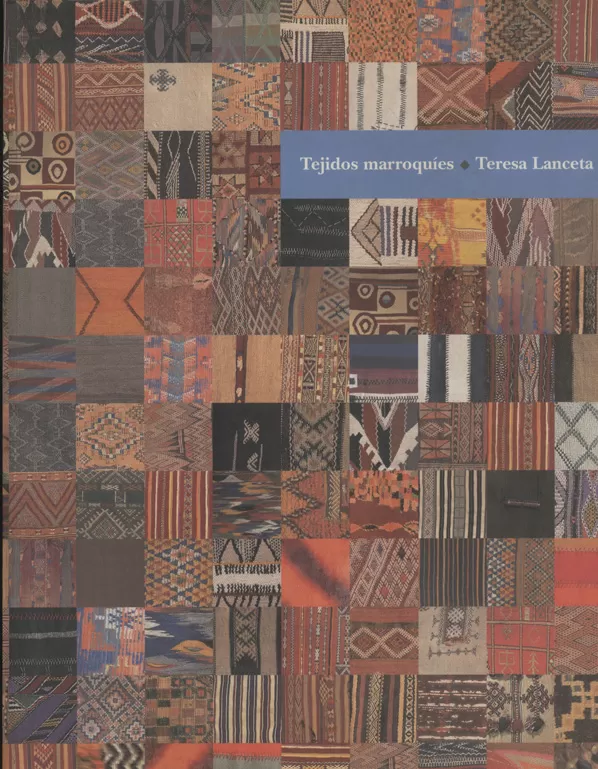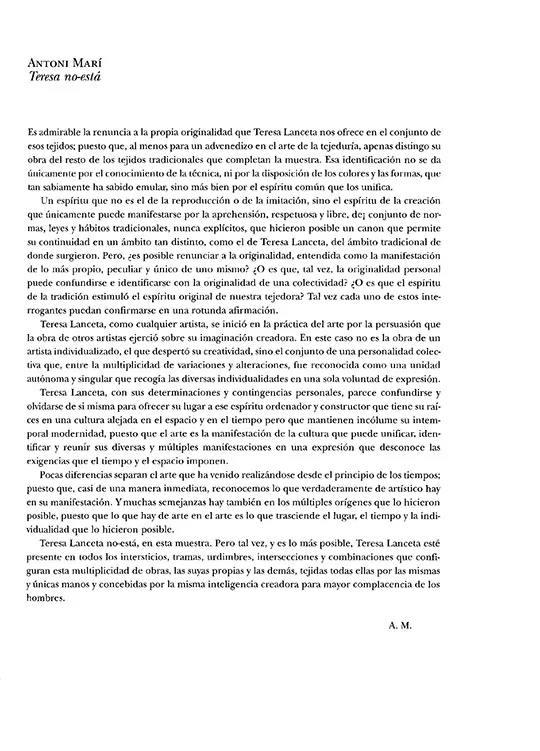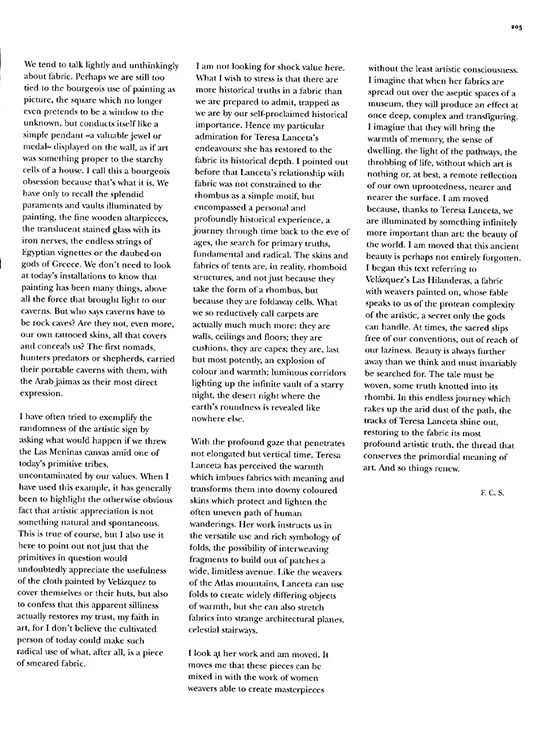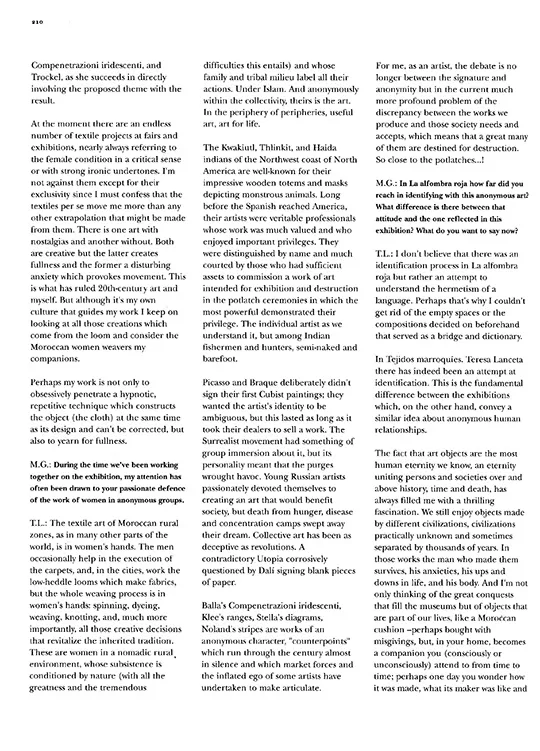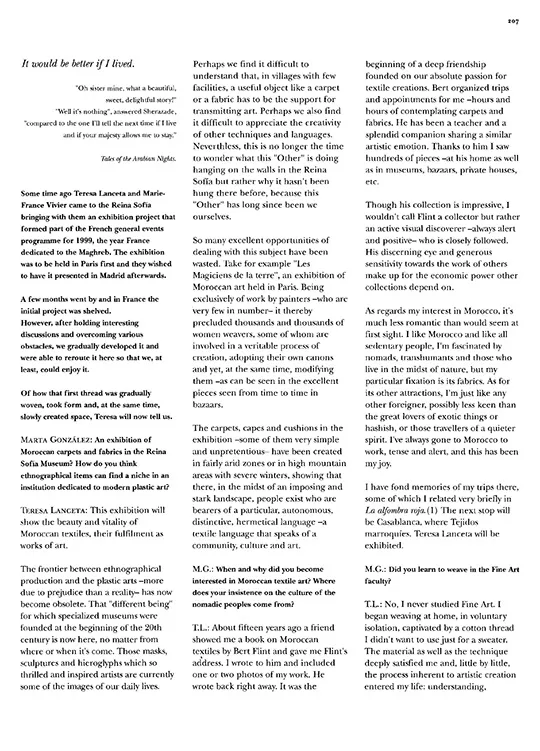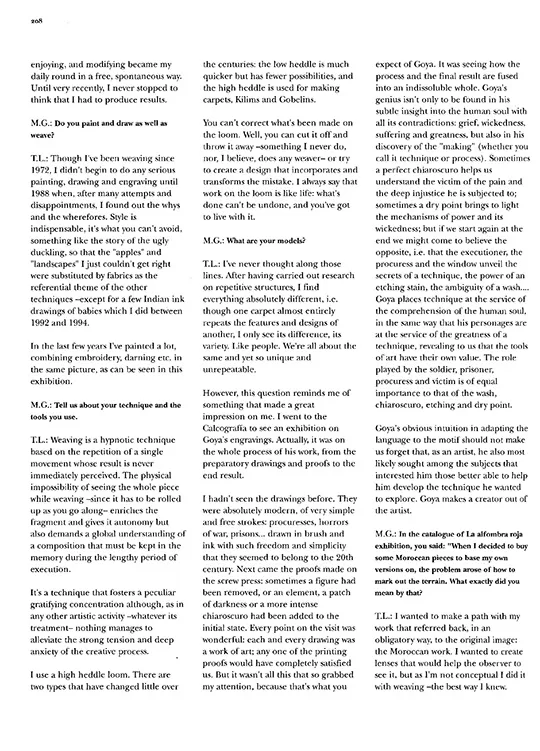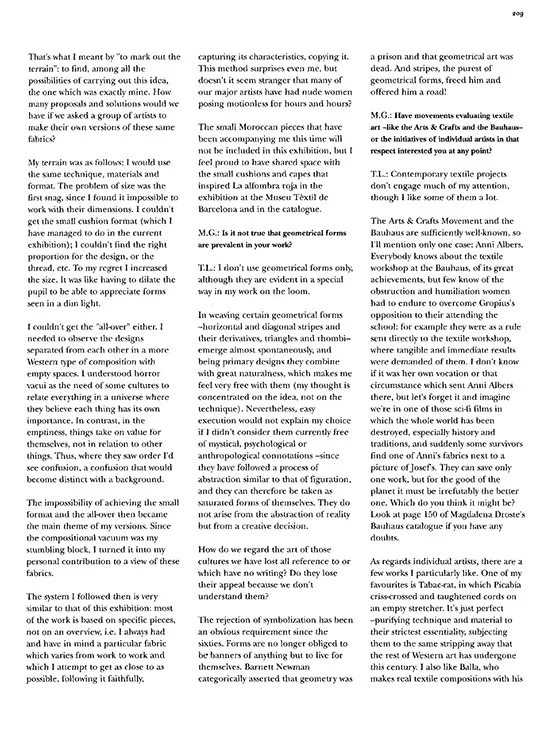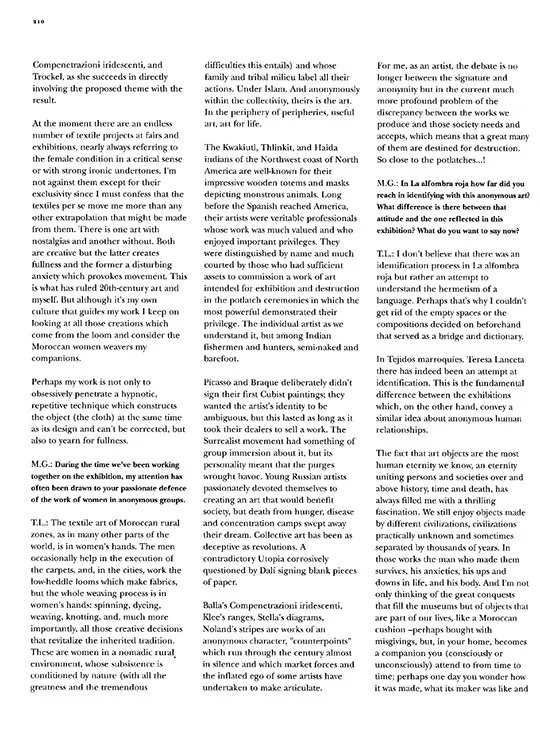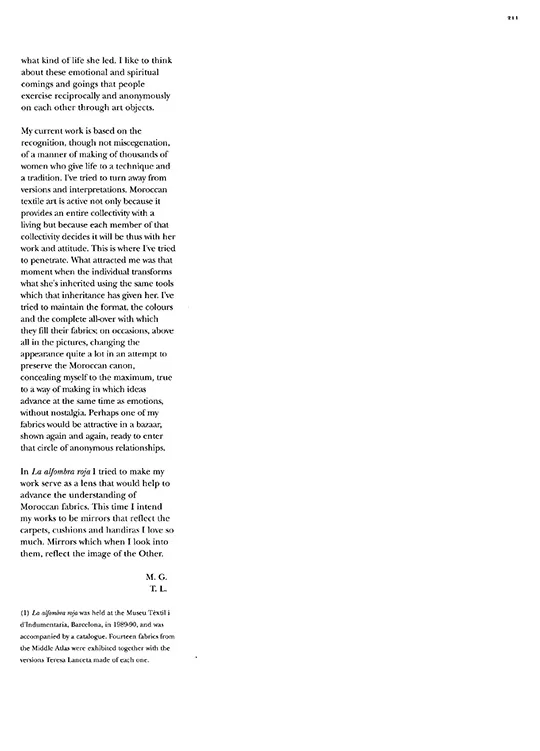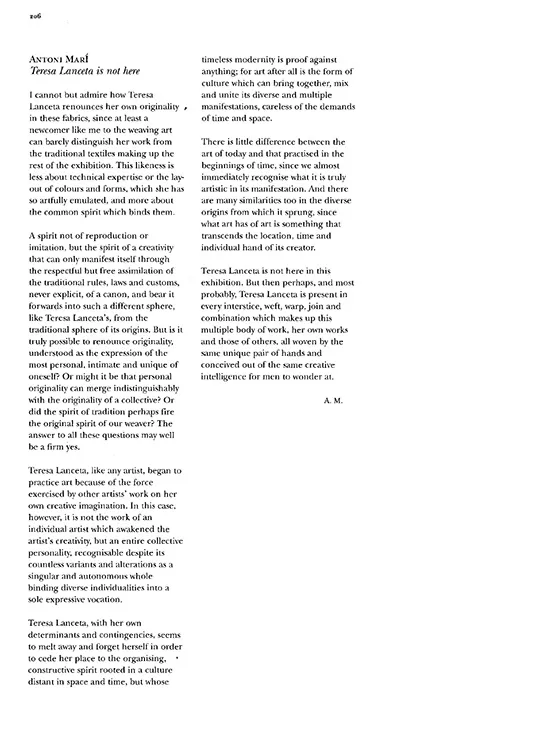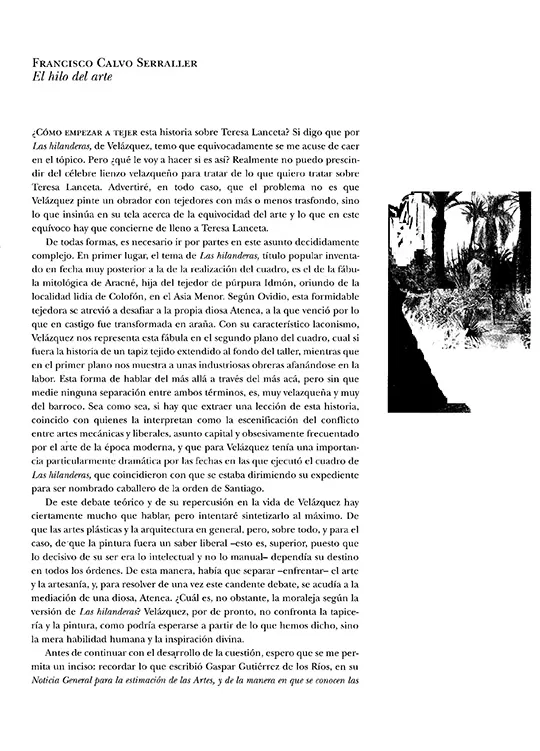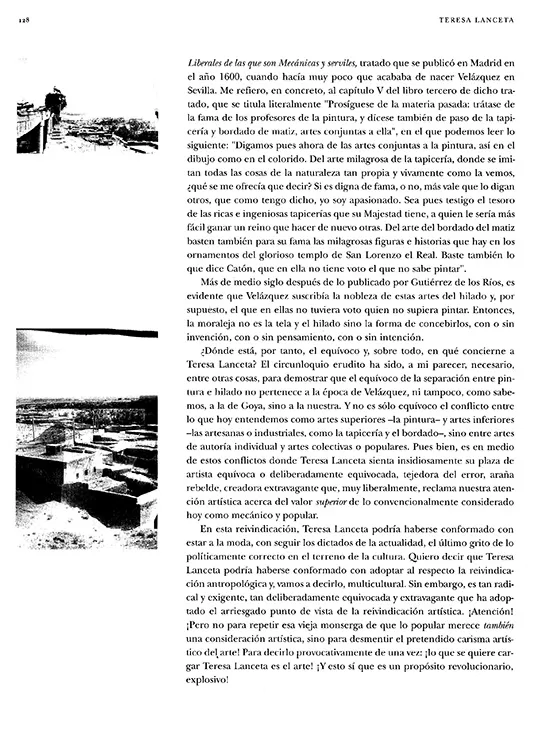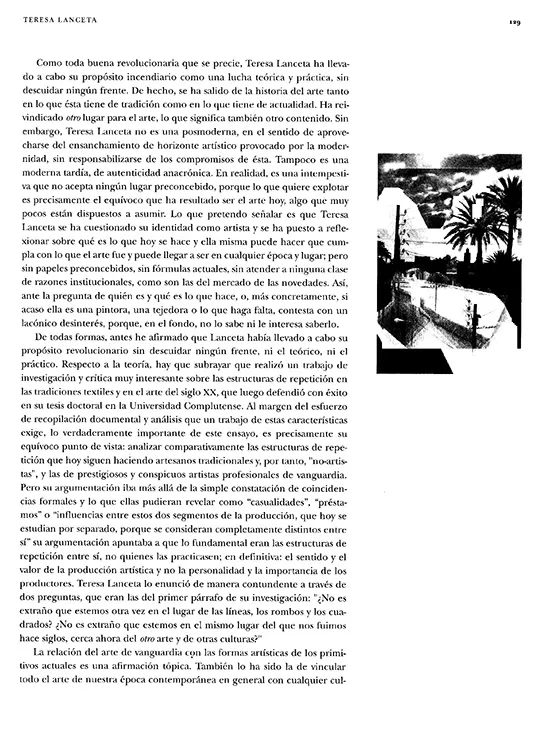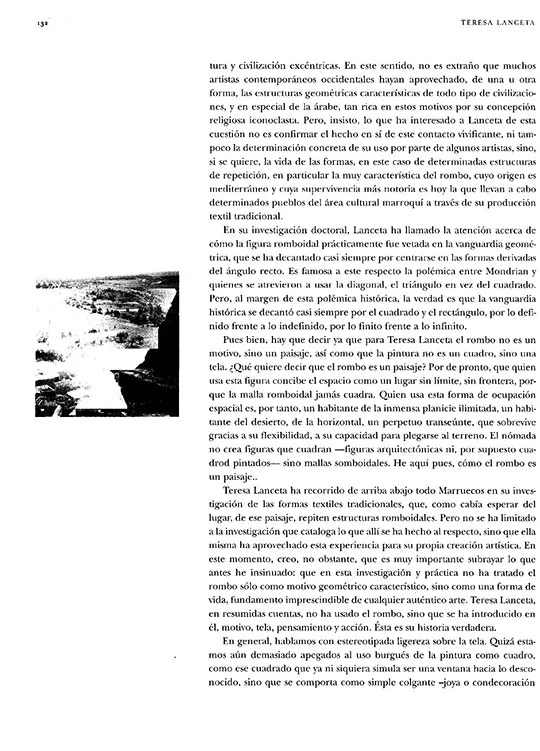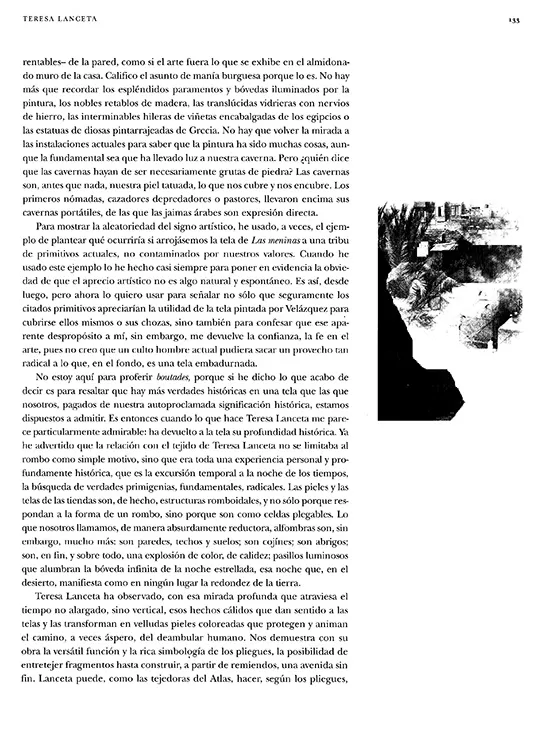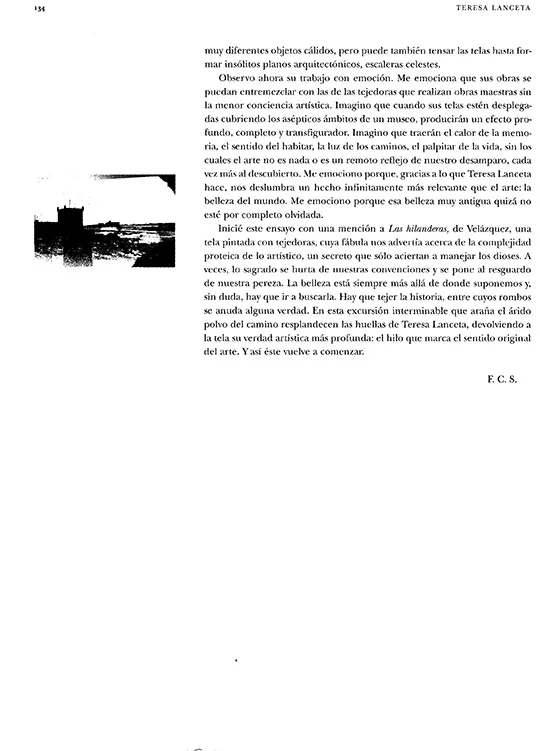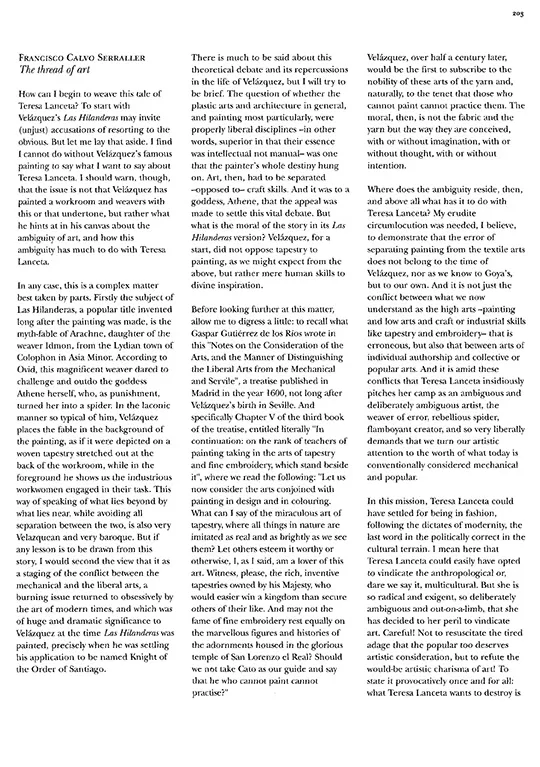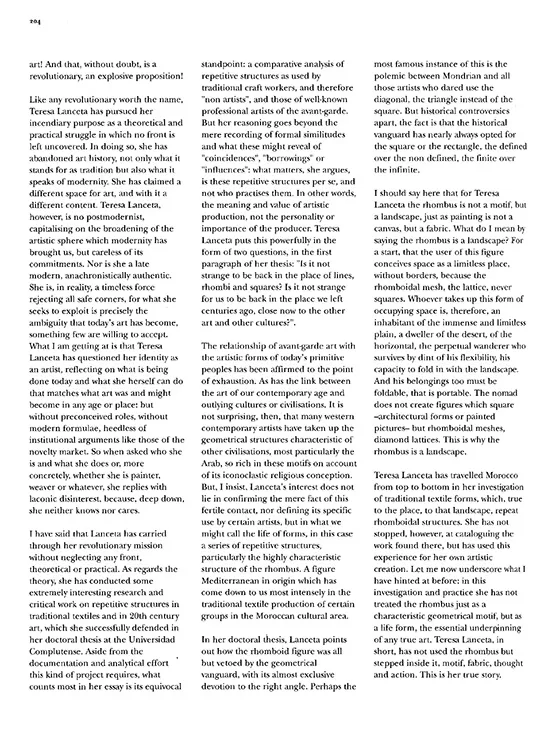Publications
Tejidos marroquíes. Teresa Lanceta.
Museo Nacional Centro de Arte Reina Sofía. Madrid/Ville des Arts. Casablanca.2000
Design: Gonzalo Armero.
Writings: Gerard Boëly, Marie France Vivier, Marcel Korolnik, Bert Flint, Antoni Marí, Francisco Calvo Serraller, Marta González y Teresa Lanceta.
Writings
- The thread of art - Francisco Calvo Serraller
The thread of art
FRANCISCO CALVO SERRALLER
How can I begin to weave this tale of Teresa Lanceta? To start with Velázquez's Las Hilanderas may invite (unjust) accusations of resorting to the obvious. But let me lay that aside. I find I cannot do without Velázquez's famous painting to say what I want to say about Teresa Lanceta. I should warn, though, that the issue is not that Velázquez has painted a workroom and weavers with this or that undertone, but rather what he hints at in his canvas about the ambiguity of art, and how this ambiguity has much to do with Teresa Lanceta.
In any case, this is a complex matter best taken by parts. Firstly the subject of Las Hilanderas, a popular title invented long after the painting was made, is the myth-fable of Arachne, daughter of the weaver Idmon, from the Lydian town of Colophon in Asia Minor. According to Ovid, this magnificent weaver dared to challenge and outdo the goddess Athene herself, who, as punishment, turned her into a spider. In the laconic manner so typical of him, Velázquez places the fable in the background of the painting, as if it were depicted on a woven tapestry stretched out at the back of the workroom, while in the foreground he shows us the industrious workwomen engaged in their task. This way of speaking of what lies beyond by what lies near, while avoiding all separation between the two, is also very Velazquean and very baroque. But if any lesson is to be drawn from this story, I would second the view that it as a staging of the conflict between the mechanical and the liberal arts, a burning issue returned to obsessively by the art of modern times, and which was of huge and dramatic significance to Velázquez at the time Las Hilanderas was painted, precisely when he was settling his application to be named Knight of the Order of Santiago.
There is much to be said about this theoretical debate and its repercussions in the life of Velázquez, but I will try to be brief. The question of whether the plastic arts and architecture in general, and painting most particularly, were properly liberal disciplines -in other words, superior in that their essence was intellectual not manual- was one that the painter's whole destiny hung on. Art, then, had to be separated -opposed to- craft skills. And it was to a goddess, Athene, that the appeal was made to settle this vital debate. But what is the moral of the story in its Las Hilanderas version? Velázquez, for a start, did not oppose tapestry to painting, as we might expect from the above, but rather mere human skills to divine inspiration.
Before looking further at this matter, allow me to digress a little: to recall what Gaspar Gutiérrez de los Rios wrote in this "Notes on the Consideration of the Arts, and the Manner of Distinguishing the Liberal Arts from the Mechanical and Servile", a treatise published in Madrid in the year 1600, not long after Velázquez's birth in Seville. And specifically Chapter V of the third book of the treatise, entitled literally "In continuation: on the rank of teachers of painting taking in the arts of tapestry and fine embroidery, which stand beside it", where we read the following: "Let us now consider the arts conjoined with painting in design and in colouring. What can I say of the miraculous art of tapestry, where all things in nature are imitated as real and as brightly as we see them? Let others esteem it worthy or otherwise, I, as I said, am a lover of this art. Witness, please, the rich, inventive tapestries owned by his Majesty, who would easier win a kingdom than secure others of their like. And may not the fame of fine embroidery rest equally on the marvellous figures and histories of the adornments housed in the glorious temple of San Lorenzo el Real? Should we not take Cato as our guide and say that he who cannot paint cannot practise?"
Velázquez, over half a century later, would be the first to subscribe to the nobility of these arts of the yarn and, naturally, to the tenet that those who cannot paint cannot practice them. The moral, then, is not the fabric and the yarn but the way they are conceived, with or without imagination, with or without thought, with or without intention.
Where does the ambiguity reside, then, and above all what has it to do with Teresa Lanceta! My erudite circumlocution was needed, I believe, to demonstrate that the error of separating painting from the textile arts does not belong to the time of Velázquez, nor as we know to Goya's, but to our own. And it is not just the conflict between what we now understand as the high arts -painting and low arts and craft or industrial skills like tapestry and embroidery- that is erroneous, but also that between arts of individual authorship and collective or popular arts. And it is amid these conflicts that Teresa Lanceta insidiously pitches her camp as an ambiguous and deliberately ambiguous artist, the weaver of error, rebellious spider, flamboyant creator, and so very liberally demands that we turn our artistic attention to the worth of what today is conventionally considered mechanical and popular.
In this mission, Teresa Lanceta could have settled for being in fashion, following the dictates of modernity, the last word in the politically correct in the cultural terrain. I mean here that Teresa Lanceta could easily have opted to vindicate the anthropological or, dare we say it, multicultural. But she is so radical and exigent, so deliberately ambiguous and out-on-a-limb, that she has decided to her peril to vindicate art. Careful! Not to resuscitate the tired adage that the popular too deserves artistic consideration, but to refute the would-be artistic charisma of art! To state it provocatively once and for all: what Teresa Lanceta wants to destroy is art! And that, without doubt, is a revolutionary, an explosive proposition!
Like any revolutionary worth the name, Teresa Lanceta has pursued her incendiary purpose as a theoretical and practical struggle in which no front is left uncovered. In doing so, she has abandoned art history, not only what it stands for as tradition but also what it speaks of modernity. She has claimed a different space for art, and with it a different content. Teresa Lanceta, however, is no postmodernist, capitalising on the broadening of the artistic sphere which modernity has brought us, but careless of its commitments. Nor is she a late modern, anachronistically authentic. She is, in reality, a timeless force rejecting all safe corners, for what she seeks to exploit is precisely the ambiguity that today's art has become, something few are willing to accept. What I am getting at is that Teresa Lanceta has questioned her identity as an artist, reflecting on what is being done today and what she herself can do that matches what art was and might become in any age or place: but without preconceived roles, without modern formulae, heedless of institutional arguments like those of the novelty market. So when asked who she is and what she does or, more concretely, whether she is painter, weaver or whatever, she replies with laconic disinterest, because, deep down, she neither knows nor cares.
I have said that Lanceta has carried through her revolutionary mission without neglecting any front, theoretical or practical. As regards the theory, she has conducted some extremely interesting research and critical work on repetitive structures in traditional textiles and in 20th century art, which she successfully defended in her doctoral thesis at the Universidad Complutense. Aside from the documentation and analytical effort this kind of project requires, what counts most in her essay is its equivocal standpoint: a comparative analysis of repetitive structures as used by traditional craft workers, and therefore "non artists", and those of well-known professional artists of the avant-garde. But her reasoning goes beyond the mere recording of formal similitudes and what these might reveal of "coincidences", "borrowings" or "influences": what matters, she argues, is these repetitive structures per se, and not who practises them. In other words, the meaning and value of artistic production, not the personality or importance of the producer. Teresa Lanceta puts this powerfully in the form of two questions, in the first paragraph of her thesis: "Is it not strange to be back in the place of lines, rhombi and squares? Is it not strange for us to be back in the place we left centuries ago, close now to the other art and other cultures?".
The relationship of avant-garde art with the artistic forms of today's primitive peoples has been affirmed to the point of exhaustion. As has the link between the art of our contemporary age and outlying cultures or civilisations. It is not surprising, then, that many western contemporary artists have taken up the geometrical structures characteristic of other civilisations, most particularly the Arab, so rich in these motifs on account of its iconoclastic religious conception. But, I insist, Lanceta's interest does not lie in confirming the mere fact of this fertile contact, nor defining its specific use by certain artists, but in what we might call the life of forms, in this case a series of repetitive structures, particularly the highly characteristic structure of the rhombus. A figure Mediterranean in origin which has come down to us most intensely in the traditional textile production of certain groups in the Moroccan cultural area.
In her doctoral thesis, Lanceta points out how the rhomboid figure was all but vetoed by the geometrical vanguard, with its almost exclusive devotion to the right angle. Perhaps the most famous instance of this is the polemic between Mondrian and all those artists who dared use the diagonal, the triangle instead of the square. But historical controversies apart, the fact is that the historical vanguard has nearly always opted for the square or the rectangle, the defined over the non defined, the finite over the infinite.
I should say here that for Teresa Lanceta the rhombus is not a motif, but a landscape, just as painting is not a canvas, but a fabric. What do I mean by saying the rhombus is a landscape? For a start, that the user of this figure conceives space as a limitless place, without borders, because the rhomboidal mesh, the lattice, never squares. Whoever takes up this form of occupying space is, therefore, an inhabitant of the immense and limitless plain, a dweller of the desert, of the horizontal, the perpetual wanderer who survives by dint of his flexibility, his capacity to fold in with the landscape. And his belongings too must be foldable, that is portable. The nomad does not create figures which square -architectural forms or painted pictures- but rhomboidal meshes, diamond lattices. This is why the rhombus is a landscape.
Teresa Lanceta has travelled Morocco from top to bottom in her investigation of traditional textile forms, which, true to the place, to that landscape, repeat rhomboidal structures. She has not stopped, however, at cataloguing the work found there, but has used this experience for her own artistic creation. Let me now underscore what I have hinted at before: in this investigation and practice she has not treated the rhombus just as a characteristic geometrical motif, but as a life form, the essential underpinning of any true art. Teresa Lanceta, in short, has not used the rhombus but stepped inside it, motif, fabric, thought and action. This is her true story.
We tend to talk lightly and unthinkingly about fabric. Perhaps we are still too tied to the bourgeois use of painting as picture, the square which no longer even pretends to be a window to the unknown, but conducts itself like a simple pendant -a valuable jewel or medal- displayed on the wall, as if art was something proper to the starchy cells of a house. I call this a bourgeois obsession because that's what it is. We have only to recall the splendid paraments and vaults illuminated by painting, the fine wooden altarpieces, the translucent stained glass with its iron nerves, the endless strings of Egyptian vignettes or the daubed-on gods of Greece. We don't need to look at today's installations to know that painting has been many things, above all the force that brought light to our caverns. But who says caverns have to be rock caves? Are they not, even more, our own tattooed skins, all that covers and conceals us? The first nomads, hunters predators or shepherds, carried their portable caverns with them, with the Arab jaimas as their most direct ex
pression. I have often tried to exemplify the randomness of the artistic sign by asking what would happen if we threw the Las Meninas canvas amid one of today's primitive tribes, uncontaminated by our values. When I have used this example, it has generally been to highlight the otherwise obvious fact that artistic appreciation is not something natural and spontaneous. This is true of course, but I also use it here to point out not just that the primitives in question would undoubtedly appreciate the usefulness of the cloth painted by Velázquez to cover themselves or their huts, but also to confess that this apparent silliness actually restores my trust, my faith in art, for I don't believe the cultivated person of today could make such radical use of what, after all, is a piece of smeared fabric.
I am not looking for shock value here. What I wish to stress is that there are more historical truths in a fabric than we are prepared to admit, trapped as we are by our self-proclaimed historical importance. Hence my particular admiration for Teresa Lanceta's endeavours: she has restored to the fabric its historical depth. I pointed out before that Lanceta's relationship with fabric was not constrained to the rhombus as a simple motif, but encompassed a personal and profoundly historical experience, a journey through time back to the eve of ages, the search for primary truths, fundamental and radical. The skins and fabrics of tents are, in reality, rhomboid structures, and not just because they take the form of a rhombus, but because they are foldaway cells. What we so reductively call carpets are actually much much more: they are walls, ceilings and floors; they are cushions, they are capes; they are, last but most potently, an explosion of colour and warmth; luminous corridors lighting up the infinite vault of a starry night, the desert night where the earth's roundness is revealed like nowhere else.
With the profound gaze that penetrates not elongated but vertical time, Teresa Lanceta has perceived the warmth which imbues fabrics with meaning and transforms them into downy coloured skins which protect and lighten the often uneven path of human wanderings. Her work instructs us in the versatile use and rich symbology of folds, the possibility of interweaving fragments to build out of patches a wide, limitless avenue. Like the weavers of the Atlas mountains, Lanceta can use folds to create widely differing objects of warmth, but she can also stretch fabrics into strange architectural planes, celestial stairways.
I look at her work and am moved. It moves me that these pieces can be mixed in with the work of women weavers able to create masterpieces without the least artistic consciousness. I imagine that when her fabrics are spread out over the aseptic spaces of a museum, they will produce an effect at once deep, complex and transfiguring. I imagine that they will bring the warmth of memory, the sense of dwelling, the light of the pathways, the throbbing of life, without which art is nothing or, at best, a remote reflection of our own uprootedness, nearer and nearer the surface. I am moved because, thanks to Teresa Lanceta, we are illuminated by something infinitely more important than art: the beauty of the world. I am moved that this ancient beauty is perhaps not entirely forgotten. I began this text referring to Velázquez's Las Hilanderas, a fabric with weavers painted on, whose fable speaks to us of the protean complexity of the artistic, a secret only the gods can handle. At times, the sacred slips free of our conventions, out of reach of our laziness. Beauty is always further away than we think and must invariably be searched for. The tale must be woven, some truth knotted into its rhombi. In this endless journey which rakes up the arid dust of the path, the tracks of Teresa Lanceta shine out, restoring to the fabric its most profound artistic truth, the thread that conserves the primordial meaning of art. And so things renew.
- Teresa Lanceta is not here - Antoni Marí
Teresa Lanceta is not here
ANTONI MARÍ
I cannot but admire how Teresa Lanceta renounces her own originality in these fabrics, since at least a newcomer like me to the weaving art can barely distinguish her work from the traditional textiles making up the rest of the exhibition. This likeness is less about technical expertise or the lay- out of colours and forms, which she has so artfully emulated, and more about the common spirit which binds them.
A spirit not of reproduction or imitation, but the spirit of a creativity that can only manifest itself through the respectful but free assimilation of the traditional rules, laws and customs, never explicit, of a canon, and bear it forwards into such a different sphere, like Teresa Lanceta's, from the traditional sphere of its origins. But is it truly possible to renounce originality, understood as the ex
pression of the most personal, intimate and unique of oneself? Or might it be that personal originality can merge indistinguishably with the originality of a collective? Or did the spirit of tradition perhaps fire the original spirit of our weaver? The answer to all these questions may well be a firm yes. Teresa Lanceta, like any artist, began to practice art because of the force exercised by other artists' work on her own creative imagination. In this case, however, it is not the work of an individual artist which awakened the artist's creativity, but an entire collective personality, recognisable despite its countless variants and alterations as a singular and autonomous whole binding diverse individualities into a sole expressive vocation.
Teresa Lanceta, with her own determinants and contingencies, seems to melt away and forget herself in order to cede her place to the organising, constructive spirit rooted in a culture distant in space and time, but whose timeless modernity is proof against anything; for art after all is the form of culture which can bring together, mix and unite its diverse and multiple manifestations, careless of the demands of time and space.
There is little difference between the art of today and that practised in the beginnings of time, since we almost immediately recognise what it is truly artistic in its manifestation. And there are many similarities too in the diverse origins from which it sprung, since what art has of art is something that transcends the location, time and individual hand of its creator.
Teresa Lanceta is not here in this exhibition. But then perhaps, and most probably, Teresa Lanceta is present in every interstice, weft, warp, join and combination which makes up this multiple body of work, her own works and those of others, all woven by the same unique pair of hands and conceived out of the same creative intelligence for men to wonder at.
- It would be better I lived. Conversation - Marta González & Teresa Lanceta
It would be better I lived
"Oh sister mine, what a beautiful. sweet, delightful story!" "Well it's nothing", answered Sherazade, "compared to the one I'll tell the next time if I live and if your majesty allows me to stay."Tales of the Arabian Nights.Some time ago Teresa Lanceta and Marie-France Vivier came to the Reina Sofia bringing with them an exhibition project that formed part of the French general events programme for 1999, the year France dedicated to the Maghreb. The exhibition was to be held in Paris fit and they wished to have it presented in Madrid afterwards.
A few months went by and in France the initial project was shelved. However, after holding interesting discussions and overcoming various obstacles, we gradually developed it and were able to reroute it here so that we, at least, could enjoy it.
Of how that first thread was gradually woven, took form and, at the same time, slowly created space, Teresa will now tell us.
MARTA GONZÁLEZ: An exhibition of Moroccan carpets and fabrics in the Reina Sofia Museum? How do you think ethnographical items can find a niche in an institution dedicated to modern plastic art?
TERESA LANCETA: This exhibition will show the beauty and vitality of Moroccan textiles, their fulfilment as works of art.
The frontier between ethnographical production and the plastic arts -more due to prejudice than a reality- has now become obsolete. That "different being" for which specialized museums were founded at the beginning of the 20th century is now here, no matter from where or when it's come. Those masks, sculptures and hieroglyphs which so thrilled and inspired artists are currently some of the images of our daily lives.
Perhaps we find it difficult to understand that, in villages with few facilities, a useful object like a carpet or a fabric has to be the support for transmitting art. Perhaps we also find it difficult to appreciate the creativity of other techniques and languages. Nevertheless, this is no longer the time to wonder what this "Other" is doing hanging on the walls in the Reina Sofia but rather why it hasn't been hung there before, because this "Other" has long since been we ourselves.
So many excellent opportunities of dealing with this subject have been wasted. Take for example "Les Magiciens de la terre", an exhibition of Moroccan art held in Paris. Being exclusively of work by painters -who are very few in number- it thereby precluded thousands and thousands of women weavers, some of whom are involved in a veritable process of creation, adopting their own canons and yet, at the same time, modifying them -as can be seen in the excellent pieces seen from time to time in bazaars.
The carpets, capes and cushions in the exhibition -some of them very simple and unpretentious- have been created in fairly arid zones or in high mountain areas with severe winters, showing that there, in the midst of an imposing and stark landscape, people exist who are bearers of a particular, autonomous, distinctive, hermetical language -a textile language that speaks of a community, culture and art.
M.G.: When and why did you become interested in Moroccan textile art? Where does your insistence on the culture of the nomadic peoples come from?
T.L.: About fifteen years ago a friend showed me a book on Moroccan textiles by Bert Flint and gave me Flint's address. I wrote to him and included one or two photos of my work. He wrote back right away. It was the beginning of a deep friendship founded on our absolute passion for textile creations. Bert organized trips and appointments for me -hours and hours of contemplating carpets and fabrics. He has been a teacher and a splendid companion sharing a similar artistic emotion. Thanks to him I saw hundreds of pieces -at his home as well as in museums, bazaars, private houses, etc.
Though his collection is impressive, I wouldn't call Flint a collector but rather an active visual discoverer -always alert and positive- who is closely followed. His discerning eye and generous sensitivity towards the work of others make up for the economic power other collections depend on.
Asregards my interest in Morocco, it's much less romantic than would seem at first sight. I like Morocco and like all sedentary people, I'm fascinated by nomads, transhumant and those who live in the midst of nature, but my particular fixation is its fabrics. As for its other attractions, I'm just like any other foreigner, possibly less keen than the great lovers of exotic things or hashish, or those travellers of a quieter spirit. I've always gone to Morocco. to work, tense and alert, and this has been
I have fond memories of my trips there, some of which I related very briefly in La alfombra roja[1]. The next stop will be Casablanca, where Tejidos marroquíes. Teresa Lanceta will be exhibited.
M.G.: Did you learn to weave in the Fine Art faculty?
T.L.: No, I never studied Fine Art. I began weaving at home, in voluntary isolation, captivated by a cotton thread I didn't want to use just for a sweater. The material as well as the technique deeply satisfied me and, little by little, the process inherent to artistic creation entered my life: understanding, enjoying, and modifying became my daily round in a free, spontaneous way. Until very recently, I never stopped to think that I had to produce results.
M.G.: Do you paint and draw as well as weave?
T.L.: Though I've been weaving since 1972, I didn't begin to do any serious painting, drawing and engraving until 1988 when, after many attempts and disappointments, I found out the whys and the wherefores. Style is indispensable, it's what you can't avoid, something like the story of the ugly duckling, so that the "apples" and "landscapes" I just couldn't get right were substituted by fabrics as the referential theme of the other techniques -except for a few Indian ink drawings of babies which I did between 1992 and 1994.
In the last few years I've painted a lot, combining embroidery, darning etc. in the same picture, as can be seen in this exhibition.
M.G.: Tell us about your technique and the tools you use.
T.L.: Weaving is a hypnotic technique based on the repetition of a single movement whose result is never immediately perceived. The physical impossibility of seeing the whole piece while weaving -since it has to be rolled up as you go along- enriches the fragment and gives it autonomy but also demands a global understanding of a composition that must be kept in the memory during the lengthy period of execution.
It's a technique that fosters a peculiar gratifying concentration although, as in any other artistic activity -whatever its treatment- nothing manages to alleviate the strong tension and deep anxiety of the creative process.
I use a high heddle loom. There are two types that have changed little over the centuries: the low heddle is much quicker but has fewer possibilities, and the high heddle is used for making carpets, Kilims and Gobelins.
You can't correct what's been made on the loom. Well, you can cut it off and throw it away -something I never do, nor, I believe, do any weaver- or try to create a design that incorporates and transforms the mistake. I always say that work on the loom is like life: what's done can't be undone, and you've got to live with it.
M.G.: What are your models?
T.L.: I've never thought along those, lines. After having carried out research on repetitive structures, I find everything absolutely different, i.e. though one carpet almost entirely repeats the features and designs of another, I only see its difference, its variety. Like people. We're all about the same and yet so unique and unrepeatable.
However, this question reminds me of something that made a great impression on me. I went to the Calcografia to see an exhibition on Goya's engravings. Actually, it was on the whole process of his work, from the preparatory drawings and proofs to the end result.
I hadn't seen the drawings before. They were absolutely modern, of very simple and free strokes: procuresses, horrors of war, prisons ... drawn in brush and ink with such freedom and simplicity that they seemed to belong to the 20th century. Next came the proofs made on the screw press: sometimes a figure had been removed, or an element, a patch of darkness or a more intense chiaroscuro had been added to the initial state. Every point on the visit was wonderful: each and every drawing was a work of art; any one of the printing proofs would have completely satisfied us. But it wasn't all this that so grabbed my attention, because that's what you expect of Goya. It was seeing how the process and the final result are fused into an indissoluble whole. Goya's genius isn't only to be found in his subtle insight into the human soul with all its contradictions: grief, wickedness, suffering and greatness, but also in his discovery of the "making" (whether you call it technique or process). Sometimes a perfect chiaroscuro helps us understand the victim of the pain and the deep injustice he is subjected to; sometimes a dry point brings to light the mechanisms of power and its wickedness; but if we start again at the end we might come to believe the opposite, i.e. that the executioner, the procuress and the window unveil the secrets of a technique, the power of an etching stain, the ambiguity of a wash.... Goya places technique at the service of the comprehension of the human soul, in the same way that his personages are at the service of the greatness of a technique, revealing to us that the tools of art have their own value. The role played by the soldier, prisoner, procuress and victim is of equal importance to that of the wash, chiaroscuro, etching and dry point.
Goya's obvious intuition in adapting the language to the motif should not make us forget that, as an artist, he also most likely sought among the subjects that interested him those better able to help him develop the technique he wanted to explore. Goya makes a creator out of the artist.
M.G.: In the catalogue of La alfombra roja exhibition, you said: "When I decided to buy some Moroccan pieces to base my own versions on, the problem arose of how to mark out the terrain. What exactly did you mean by that?
T.L.: I wanted to make a path with my work that referred back, in an obligatory way, to the original image: the Moroccan work. I wanted to create lenses that would help the observer to see it, but as I'm not conceptual I did it with weaving -the best way I knew.
[1] La alfombra roja is an exhibition that took place at the Museu Tèxtil i d'Indumentaria de Barcelona in 1989-1990. There Teresa Lanceta made versions of fourteen fabric from Middle Atlas, exhibited and cataloged as a unitary whole.
